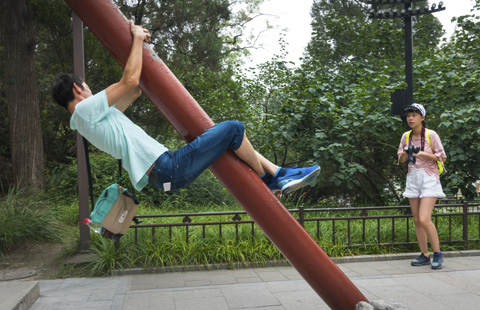Tiangong II space lab ready for launch
By Zhao Lei in Jiuquan,Gansu (China Daily) Updated: 2016-09-15 02:05China will launch the Tiangong II space laboratory on Thursday night, paving the way for a Chinese manned space station, Deputy Director Wu Ping of the China Manned Space Agency said on Wednesday.
Wu, also spokeswoman for the agency, told reporters at a news conference in the Jiuquan Satellite Launch Center that a Long March 2F carrier rocket was being fueled and would lift the Tiangong II from the Jiuquan center on 10:04 pm Thursday.
"By now, all of the mission’s elements have completed their preparations and rehearsals,” she said.
"The Tiangong II mission will lay a solid foundation and gather valuable experience for the building and operation of our future manned space station,” she said.
Tiangong II, China’s second space lab, has two cabins with different functions — the experiment cabin will be hermetically sealed and will act as the astronauts’ living quarters, and the resource cabin will contain solar panels, storage batteries, propellant and engines.
The space lab is 10.4 meters high, 3.35 meters in diameter and weighs 8.6 metric tons. It is designed to work two years in the space, Wu said.
China launched its first space lab, Tiangong I, in September 2011. Despite its designated life span of two years, it was in service for four and a half. It made six automatic and astronaut-controlled dockings with China’s Shenzhou VIII, Shenzhou IX and Shenzhou X spacecraft.
During its mission, Tiangong II will dock with the Shenzhou XI manned spacecraft and Tianzhou 1 cargo spaceship.
The space lab’s main tasks will be to accommodate astronauts’ medium length stay in it and test life-support technologies, and it will be used to test in-orbit refueling and repair plans, conduct experiments in space medicine and space sciences, and examine technologies for the future manned space station, Wu said.
In addition, it will carry 14 pieces of equipment for scientific research and experiments in space, she added.
After entering an initial orbit at about 380 kilometers above Earth, the space lab will perform some of its experiments and also test its equipment.
It will then maneuver to a rendezvous orbit at an altitude of 393 km to dock with the Shenzhou XI manned spacecraft, which will be launched in mid-October from the Jiuquan center. The two male Chinese astronauts will stay in the space lab for 30 days.
The two are scheduled to make Chinese astronauts’ longest stay in space to date: 33 days. Chinese astronauts’ current longest space journey was a 15-day mission in June 2013 involving Shenzhou X and Tiangong I.
Tiangong II will also take part in international missions.
Wu said the space lab will carry the world’s first high-sensitive gamma-ray burst detector, which was codeveloped by engineers from China and European Space Agency.
It will also execute an in-orbit study of the effects of weightlessness on cardiovascular functions, a joint effort by Chinese and French scientists, she added.
Space experts and officials from several nations including Germany, Italy and Pakistan, as well as the European Space Agency will be in the Jiuquan center to witness the launch.
China’s manned space program intends to put a permanent manned space station into service. It will consist of a core module attached to two 20-ton labs, around the year 2022, according to the manned space agency.
- Biggest typhoon of 2016 to obliterate full moon for holiday
- Letter from Taiwan isn't good news, scholars say
- 45 NPC deputies unseated for fraud
- Sponge cities not built in a day: authority
- Executives jailed over online pornography videos
- It's anchors aweigh in South China Sea
- Global satellite network planned to boost internet
- Progress in judicial protection of rights
- Hangzhou sees boom in tourism after G20 Summit
- Scientists discuss 'air corridor' of south to north water diversion











